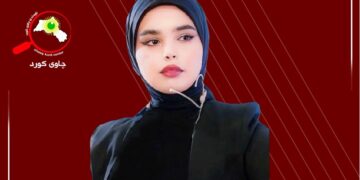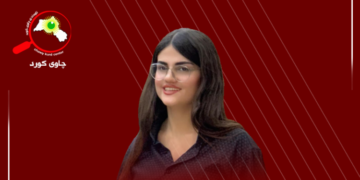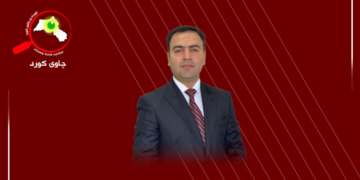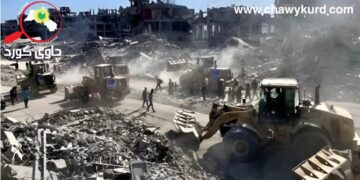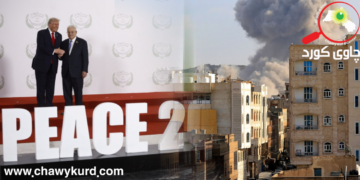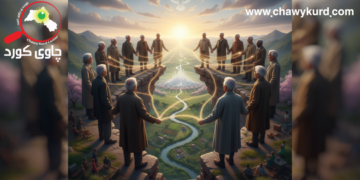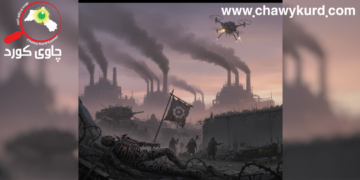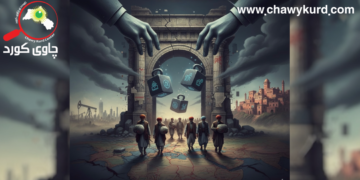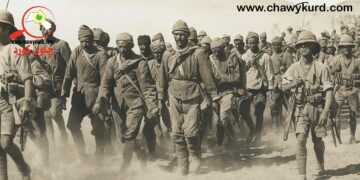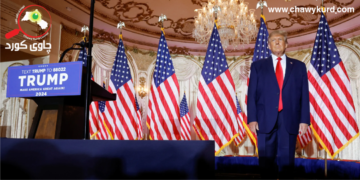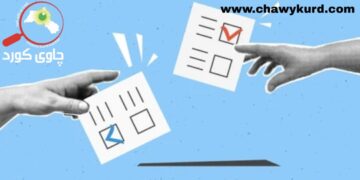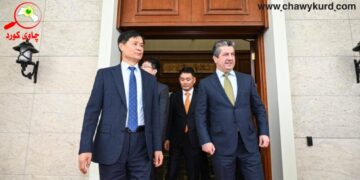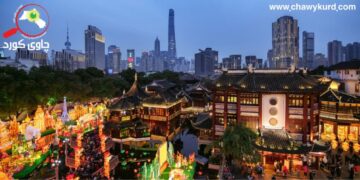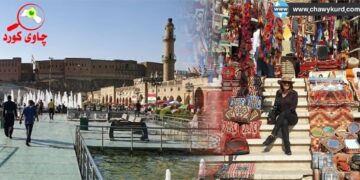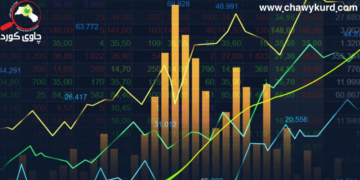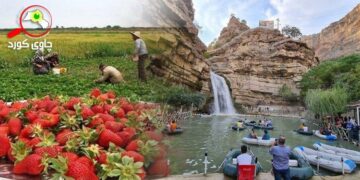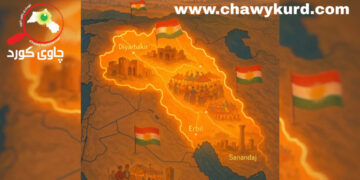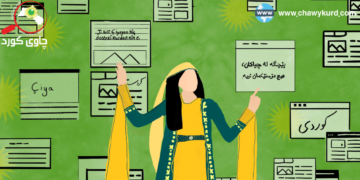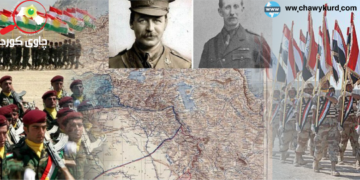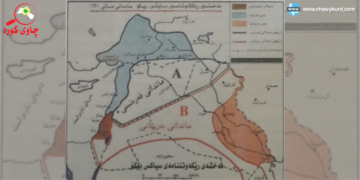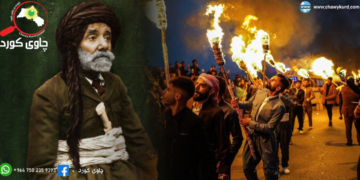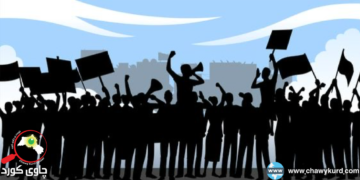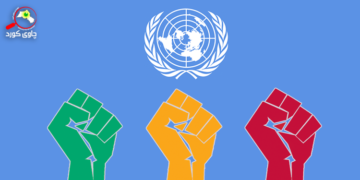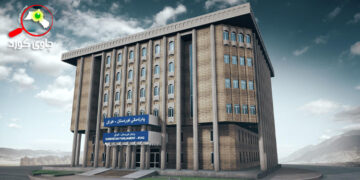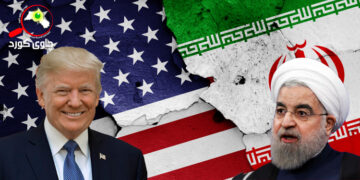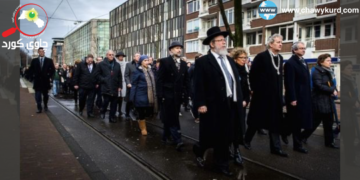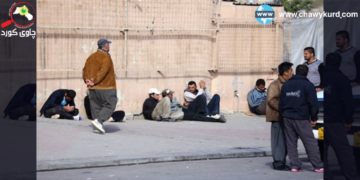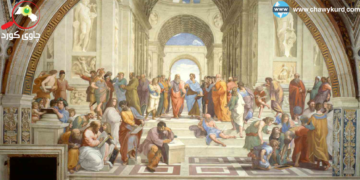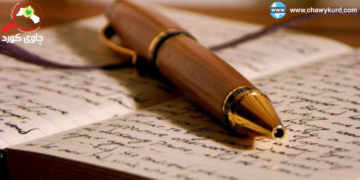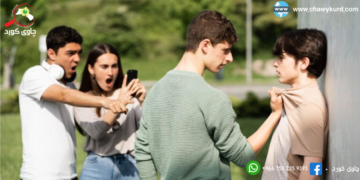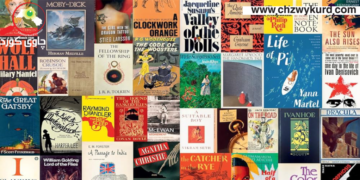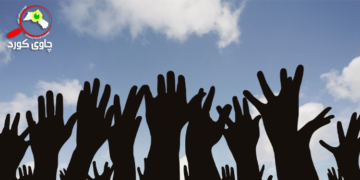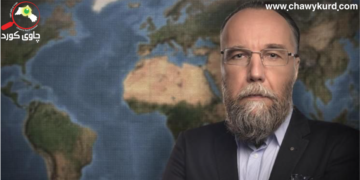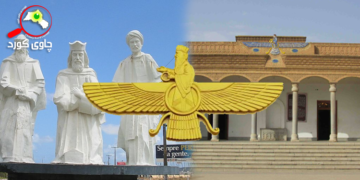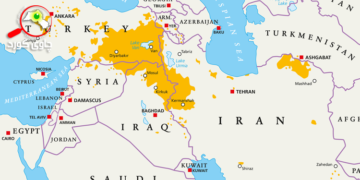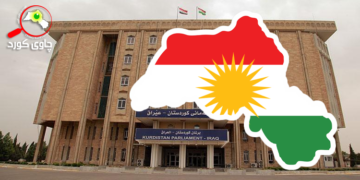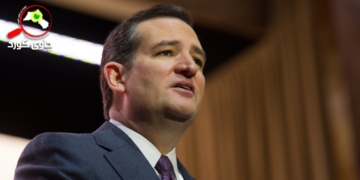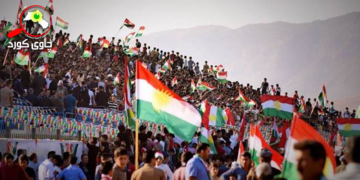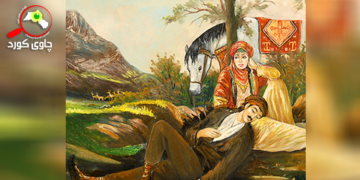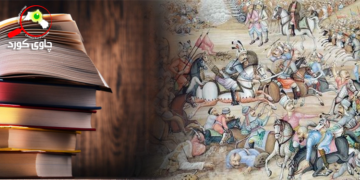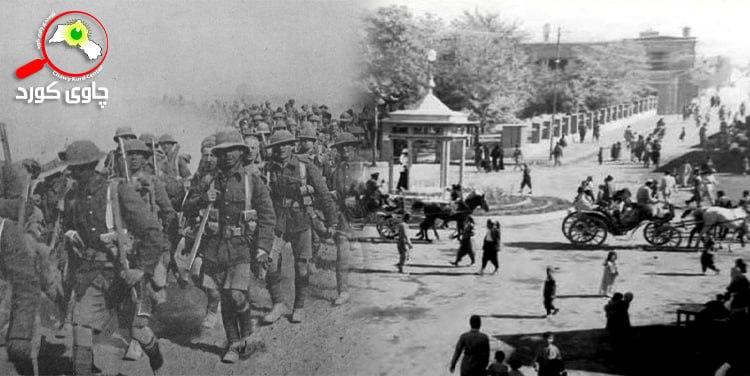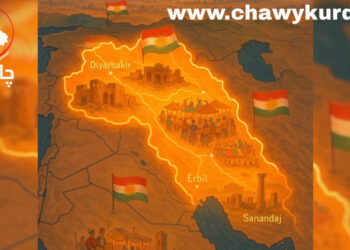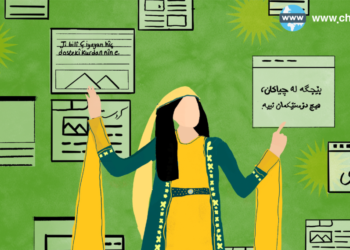The first mass demonstration in Sulaimaniya took place on 16 July 1930 on the occasion of Prince Ghazi’s visit to the town. Participants marched protesting against the new Treaty on the grounds that it had no provision for the Kurds. Speeches were made in Ghazi’s presence by Ramzi Fattah Effendi and Tawfiq Qazzaz, the leaders of the Sheikh Qadir party.36 Excitement and anti-Arab sentiment grew quickly due to the visit of the High Commissioner and the Iraqi Prime Minister to Sulaimaniya, scheduled for 10 August 1930. The previous day, Ahmed Faiq Beg, an official working for the local land registry office and a former member of the Sulaimaniya Court, arrived from Kirkuk and spoke in favour of the Arab government, announcing that he was going to be made mutasarrif instead of Tawfiq Wahbi. After this, he was mobbed by young students of government schools and had to seek refuge in the police station. From there he was put in a car and sent back to Kirkuk with a warning not to return. The following day, tents and shelters were erected on the aerodrome where a large crowd assembled to welcome the authorities. Surprisingly, Faiq Beg was amongst the arty arriving with the High Commissioner and the Prime Minister. He was attacked by a section of the crowd who threw stones injuring him. The High Commissioner was unaware of the incident and the public reception went on. With British permission, the organizers invited a student to deliver an address to the High Commissioner, ignoring the Iraqi Prime Minister Ja‘far Pasha.
The address read as follows:
The Kurdish students are, with extreme pleasure and courage, proud to welcome Your Excellency on your arrival in Kurdistan. . . . We are fully aware that many other communities have been trained and tutored by you. We assure Your Excellency that we will be of some use to you. . . . The Motherland of Kurds hopes to grow under the protection of the British Government. Long Live British Government. Long Live Your Excellency who supports the Kurds.37
The day after, demonstrations took place in the streets of Sulaimaniya. The nucleus of the demonstrators was a body of 50 students encouraged and led by two schoolmasters, Muhammad Salih Qaftan and Rafiq Hilmi, and members of the Zanistıˆ-i-Kurdistan night school. In addition, in the words of a British official, there were ‘hooligan followers of Sheikh Qadir and his friends’.38 In the Serai, the main administrative building of the town, a meeting between the authorities and the leaders of the two blocs (autonomists and unionists) took place in spite of the fact that the main leaders of the ‘pro-Baghdad’ party were absent, except for Hajji Mulla Mohidin, one of the richest merchants in Sulaimaniya and a man of local standing.
The pro-Kurdish party submitted a request for an independent government under the British or some form of mandate from the League of Nations. Upon leaving the meeting, Ramzi Fattah Effendi, the speaker’s nationalist bloc, was greeted by a ‘huge crowd that carried him round the town on their shoulders’.39 Encouraged by this euphoric atmosphere, the party immediately elaborated the petition to be submitted
Urban Mobilization in Iraqi Kurdistan 543 to the League of Nations. It was further decided that should no progress be made along the present lines, a movement inspired by the Indian tactics of non-payment of taxes should be organized.40
In this respect, it is interesting to note that the British had involuntarily induced the residents of Sulaimaniya to follow developments in India since 1920 through the Kurdish prisoners of war which had returned to the town from Sumarpur, Bellary and Nowgong. In the words of British officers, all residents appeared ‘to have become inculcated with the doctrines of the professional Indian malcontent’. The repatriated prisoners circulated the first anti-British propaganda, calling to put an end to the process of ‘Indianizing Kurdistan’ (Hindiyan bunawa), which in their terms meant the degradation of chiefs and the impoverishment of the peasants.41 Evidence of further interest in the anti-British movement in India was the fact that Tawfiq Qazzaz, one of the most prominent leaders of the nationalist party in Sulaimaniya, was known as Ghandi amongst his friends.42
Being aware of these developments, K. Cornwallis, adviser to the Iraqi Ministry of the Interior, urged the Administrative Inspector of Sulaimaniya to impress upon the Sulaimani leaders that they should wait quietly for the decision of the League regarding Kurdish autonomy.43 However, British attempts to calm down the situation in Sulaimaniya were fruitless. The intervention of the third actor, the Iraqi government, in the escalade of the tension between the two blocs was decisive in this respect. At the end of August 1930, Tawfiq Wahbi was dismissed by Baghdad and accused of encouraging separatist sentiments among the residents of Sulaimaniya.
Following this decision, the Kurdish nationalist party organized demonstrations to protest against Wahbi’s dismissal. The spread of rumours regarding the possible appointment of Ahmad Tawfiq Beg to replace him had a further disturbing effect on the general situation. The appointment was seen as an attempt to create a division among the nationalist party. Ahmad Tawfiq Beg had previously been the mutasarrif of Sulaimaniya and had entered into conflict with some local leaders within the Zanistıˆ-i-Kurdistan club and, more importantly, he was the brother-in-law of Babakr Agha, the chief of a ‘pro-Baghdad’ section of the Pizhdar tribal confederation, one of the most powerful Kurdish tribes which was at odds with Sheikh Mahmud and his brother, Sheikh Qadir. The result was an increase in the activities of Qadir’s party, which, quite apart from nationalist aims, was faced with losing a personal friend, Tawfiq Wahbi, and getting a new mutasarrif who, whatever his politics, was unfriendly to them. In spite of the past conflicts between Sheikh Qadir and Sheikh Mahmud, the former now sought the support of the latter, and the two brothers arranged a reconciliation, bringing the vast majority of the Pizhdar onto their side.
There were also a number of prominent notables, such as Hajji Mulla Mohidin and Mustafa Pasha, who were in favour of carrying out this election. They became the victims of several acts of hostility. Thus, during the official meeting where the Sheikh Qadir bloc decided to boycott the upcoming election, on 16 July 1930, Mustafa Pasha started to make a pro-Arab and anti-British speech, but was not allowed to finish. He was violently hustled out of the meeting and escorted home under police protection, where he remained in hiding for a few days. Furthermore, threatening notices decorated with a blood-stained Kurdish dagger and a revolver were distributed to all people suspected of pro-government sympathies.44
In early September, Captain Alban informed the Sulaimani leaders, who had previously expressed their unwillingness to participate in the election, of his intention to resume the electoral procedure and warned them of their responsibilities as the keepers of public security. From that moment on, accounts regarding the events differ. British reports still constitute the most important written sources about the riots which followed on 6 September 1930. Obviously, the leaders of the nationalist party and participants did not call the event a ‘riot’ or identify themselves as ‘rioters’. Both the poems written by eye-witnesses45 and local historiography46 speak, on the contrary, of a popular uprising and of a massacre perpetrated by the Iraqi army. As Charles Tilly suggests, the term ‘riot’ embodies a political judgement rather than an analytical distinction. In this sense, the authorities and observers label as ‘riots’ the destructive gatherings of which they disapprove ‘but they use terms like demonstrations, protest, resistance or retaliation for essentially similar events which they approve’.47
Whilst nationalist leaders claimed their innocence and blamed the Iraqi government for these incidents, British officers did not share a unified narrative. Needless to say, the British administration was not monolithic in its political positions: the High Commissioner’s priorities could clash with those of the provincial authorities, and local officers did not always uniformly interpret or agree with national or provincial policy. The following narratives of the riots are a good example of how, among British officials, perception of their own role in Iraq and the place of Kurds in the Iraqi state differed. While the first report, written by the Administrative Inspector, described the ‘riot’ as the product of ‘elite manipulation’ against British policy, the second, composed by the Special Service Officer, the ‘eyes and ears’ of the intelligence service in Sulaimaniya, underlined the ‘provocation’ by the authorities to Sulaimaniya’s inhabitants who ‘spontaneously’ demonstrated to show their anger. Whereas the former implied the general will of the Kurdish population to integrate into the Iraqi state, the latter, on the contrary, emphasized popular animosity towards the Arab government.
The Administrative Inspector Captain Alban wrote the most comprehensive report about the events. According to this report, on the morning of 6 September, invitations were sent to some 30 notables, representing various gerhek (neighbourhoods) of the town, to go to the Serai to vote. A little later it was reported that some 50 students and serseris (hooligans) were parading through the bazaar making shopkeepers close their shops and gathering the crowd near the Serai. The mob increased due to a large number of ‘hooligans and roughs’ and gradually became rowdier. Suddenly, a section of the crowd started using chairs from a tea shop as weapons against the police, some of whom were injured. Stones were aimed at the Serai and the police, while the number of slings, clubs and long sticks among the crowd increased. A company of infantry arrived and demonstrators stopped the stone throwing. The troops fixed bayonets and were assigned into fighting squads. It was then observed that rioters armed with clubs were attacking the soldiers, while paving stones and chairs were being hurled at them as they advanced steadily.48 A shot was then heard and an Iraqi soldier fell dead. Some automatic pistol or revolver shots were fired and two soldiers were wounded. The troops immediately opened fire, and the crowd quickly disappeared leaving a few dead and wounded in the streets. Urban Mobilization in Iraqi Kurdistan 545 According to Captain Alban, the casualties among rioters were 13 dead and 23 wounded, ‘all people of the lower classes’.49
The author’s conclusion was that the riot was caused by the determination of the leaders to wreck the elections by ‘terrorist methods’, their other weapons of propaganda and persuasion having been found ‘insufficient to win over all notables and citizens to their camp and thus stop the elections by a general boycott’.50 The ‘riot’ was thus, according to this version of events, not spontaneous but organized and directed. Inspired by the imperialist rhetoric of elections as a beacon of civilization, the Administrative Inspector considered that, while the loss of life that occurred was regrettable, it was preferable that a few ‘hooligans and roughs’ should be shot than ‘that respectable law-abiding citizens taking part in a parliamentary election should be exposed to intolerable outrage and intimidation’. For it was not only security in Sulaimaniya but British prestige that were in jeopardy.51
A different version of the event was recounted by the Special Service Officer in Sulaimaniya, P.S. Mumford. He considered that the direct cause of the riot in Sulaimaniya was the attempt on the part of the Iraqi government to obtain a reversal of the decision of 16 July as to the boycott of the elections.52 That the government did understand the risks it was taking was obvious from the fact that the police were warned the night before the event, and that police protection was sent to escort the delegates to the meeting before any signs of trouble had occurred. Extra policemen had been posted in the bazaar and the Serai with orders to prevent the shops from being closed and to keep the crowds from gathering near the Serai.
According to P.S. Mumford, when rumours about the decision taken by Alban spread through Sulaimaniya, the crowd slowly collected, shouting they did not want to hold the elections. Then an attempted arrest of a noisy youth upset the mood of the people and they attacked the police with sticks and stones. Half an hour later, a company of Iraqi army troops arrived and opened fire, although, according to Mumford’s sources, it did not appear that any firearms had been used by the crowd.
The demonstrators had 16 killed, including 10 boys, and about 50 wounded, while the soldiers had four men slightly wounded and one killed by mistake by another soldier. That afternoon the leaders of the nationalist party were arrested, as well as people directly implicated in the riots.53 A hundred arrests had been made by September.
During the following days, P.S. Mumford, having received numerous complaints from the town’s residents, decided that further investigation should be made into the events of 6 September. His investigation ‘made clear’ that, contrary to Alban’s report, most of the delegates (small shopkeepers) for the attempted election meeting on that day were there ‘by force and that they were unwilling participants’.54
Besides the exact development of the shooting, it seems obvious according to two British reports that the participants in the demonstrations were involved in the escalation of violence by using all the means available to them to stop the disputed election. In this sense, the violence which erupted on 6 September was the consequence of a rational strategy of political mobilization. The success of the demonstrations and intimidation of political opponents during the summer of 1930 had encouraged the autonomist bloc to proceed in this way. As Captain Alban had very well understood, the organizers and participants had ‘learned the power of mobs and hooliganism’.55 While it is probable that participants and organizers of that mass demonstration miscalculated the exact consequences of their actions and that there was an element of spontaneity in it, the previous incidents and collective actions, as well as the use of ‘weapons’, clubs, sticks and stones, tell us that ‘violent specialists’ or ‘mob specialists’ had appeared in Sulaimaniya. But why had violence gained prominence as the main ‘repertoire of collective action’ – to quote Charles Tilly – within the nationalist party?
Since July 1930, Sheikh Qadir’s party had resorted to violence to achieve two complementary goals. On the one hand, it aimed to discredit the opponent’s perceived ‘accommodationist’ position: participation in the elections and the acceptance of the 1930 British–Iraqi Treaty by the ‘pro-Baghdad’ party. On the other hand, the state had played a critical role in siding with the ‘pro-Baghdad’ bloc involved in the local political competition. In doing so, it had created opportunities and reasons for Sheikh Qadir’s bloc to use violence to renegotiate its position. State intervention had also deepened the ‘ethnic boundaries’56 between the Kurds, represented by Sheikh Qadir’s party, and the Arabs, represented by the Iraqi soldiers who suppressed the rioters. The Kurdish Nationalist Party used the power of mobs and violence as an effective tool for political mobilization in order to build the contours of a new political community. Through violence and victimization, Sheikh Qadir’s party intended to build the ‘we-group’, the Kurds, as opposed to ‘them’, the Arabs, the ‘enemy’ with whom conflicts can not be resolved.57 In the end, within a context of conflict between the Kurds and the Arabs, the ‘moderate’58 bloc of Sulaimani leaders would either join the ‘radicals’59 or simply back them. Paradoxically, the direct winner of the urban mobilizations between 1929 and 1930 was not Sheikh Qadir and his followers but Sheikh Mahmud. The immediate arrest of Sheikh Qadir after the riots gave Sheikh Mahmud an opportunity to return to the arena of Kurdish politics and present himself as the champion of Kurdish rights in Iraq.
The Kurds were, according to Sheikh Mahmud, ‘victims’ of oppression and it was therefore impossible for them to live together with the Arabs. In his own words: Owing to the incident in which the Arabs had no right to use machine guns on Sulaimaniya, all the Kurds are agitated. It is therefore absolutely impossible that the two factions be on friendly terms with each other . . . From Zakho up to beyond Khanaqin all together, in the same tongue and with one heart demand the formation of Kurdish Government under British Mandate.60
Sheikh Mahmud made further attempts to win Sulaimaniya’s inhabitants to his cause by making use of the ‘martyrs’ of ‘Black September’. Between October 1930 and March 1931, he wrote several proclamations to the ‘people of Sulaimaniya with hearts on fire’ to keep alive the memory of those events and to urge people to mistrust the government and especially King Faysal, ‘the real murderer of our martyrs’ and the ‘usurper of the Kurdish rights’.61 It is not surprising that as a chief of the Sufi Order, Sheikh Mahmud used religious symbols and discourse to give legitimacy to his struggle for the ‘Kurdish rights’ and to call on the ‘townsmen’ of Sulaimaniya to follow him: ‘Today, the mountaineers have the right . . . to say that they are the people who can obtain the rights of the townsmen and of all the Urban Mobilization in Iraqi Kurdistan
Kurds. . . . The townsmen should also follow the example of their mountaineer brethren, and should undertake to follow them even to death.’62
Sheikh Mahmud also intended to convince the Assyrians, especially those enlisted in the Levies63 and the police, to desert their duties and join him.64 His success in this respect was, however, limited. By January 1931, only seven Kurdish soldiers from the Iraqi army, nine policemen (six Kurds and three Assyrians) and four students had joined his side.65 Sheikh Mahmud failed to organize a mass revolt and had to surrender to the British in the spring of 1931, since the majority of urban residents and tribes of the Sulaimaniya district did not join the movement,66 with the exception of his most loyal followers among the tribal and religious chiefs (Pizhdar, Shilana, Ghawara and Hamawand). However, Sheikh Mahmud had succeeded in becoming a popular hero in Sulaimaniya amongst the nationalist effendiyya and the popular classes at large.67 Collective memory both in Sulaimaniya and in the whole of Iraqi Kurdistan rapidly neglected his ambiguous links with the Kemalist regime, the British and the Shia leaders since 1918, and made Sheikh Mahmud not a‘bandit’,68 as he was often referred to by the Iraqi government and British officials, but a national hero.69
Finally, Sheikh Mahmud also succeeded in transforming the 6 September riots into a symbol of national resistance to the Arabs up until 1940s.70 The question remains why, in spite of certain processes of radicalization of the political arena in Sulaimaniya, there was no ‘routinization’71 of the rioting in the town. One can put forth two complementary hypotheses. On the one hand, the return of Sheikh Mahmud to the political scene led to a shift in the centre of gravity of Kurdish activities from the town to the countryside until May 1931. On the other hand, the failure of Sheikh Mahmud’s movement in 1931 showed that sporadic revolts against the Iraqi government without the backing of Great Britain had no political future. Sulaimaniya’s nationalist elites finally realized that the mandatory powers, including British officers favourable to the Kurds such as C.J. Edmonds, wanted the integration of Kurdistan to the Iraqi state. Thus, by 1931, there was a tendency on the part of local political leaders to await the decision of the League of Nations with regard to the termination of the Mandate.72
The creation of ‘Southern Kurdistan’ by Great Britain in 1918 allowed the reconstitution of the urban notability of Sulaimaniya and the gradual extension of nationalist rhetoric among its inhabitants after the widespread disruption caused by the war and the collapse of the Ottoman Empire.73 British Political Officers took part in the process of building local identities by defining the arena in which various political factions (pro-autonomy/pro-Baghdad) entered into competition, the categories in which the groups were arranged (Kurdish/Arab), and by defining recognized leaders among residents of Sulaimaniya.
The intervention of the British officials and the Iraqi state generated a conflict between two blocs of leaders, the pro-Kurdish and the pro-Arab parties, who were fighting over symbolic political resources at the local and regional level. In this sense, the radicalization of political mobilization which led to the riots of 6 September 1930 must be understood both as the response of the Kurdish nationalist party to the nonrecognition of Kurdish rights in the Anglo-Iraqi Treaty of 1930, and to the challenge set by the local partisans of the Iraqi government in Sulaimaniya.
The central role assumed by Sheikh Mahmud in the phase of agitation in the rural zones of Kurdistan after the riots, and particularly between 1930 and 1931, caused the marginalization of urban-based nationalist elements active from the political struggle, thus marking the decline of urban mobilization in Sulaimaniya until the Second World War.
Notes
Jordi Tejel Gorgas gratefully acknowledges the grant provided by the Swiss National Science Foundation to support his research in the Public Record Office and at the School of Oriental and African Studies (London). Special thanks to Dr. Nelida Fuccaro of SOAS for her supervision, and to Dr. Kamaran Ahmad Mantik of Arbil University for supplying a selection of Kurdish poems in connection with the events of 6 September 1930.
- For the role of the Qadiri Sheikhs in Iraqi Kurdistan see M. van Bruinessen, Mullas, Sufis and
Heretics: The Role of Religion in Kurdish Society (Istanbul: The Isis Press, 2000), pp.213–29.
- For an analysis of the Mandate structure in Iraq see P. Sluglett, ‘The Mandates: Some Reflections on the Nature of the British Presence in Iraq (1914–32) and the French Presence in Syria (1918–46)’, in P. Sluglett and N. Me´ouchy (eds.), The British and French Mandates in Comparative Perspectives (Leiden and Boston: Brill, 2003), pp.103–27 and 361–84; P. Sluglett, Britain in Iraq. Contriving King and Country (London: I.B. Tauris, 2007).
- In 1925 the Sulaimaniya population was about 10,000 people, of whom 9,000 were Muslim Kurds, 750 Jews and 129 Assyrians. C.J. Edmonds, Kurds, Turks and Arabs (London: Oxford University Press, 1957), p.80.
- Tobacco, grown in the Rowanduz area, was the largest export from Sulaimaniya, but the town was also a distribution point for imports from Europe to the rest of the Kurdish districts via Baghdad and Mosul, and a collecting place for exports of rubber, wool and the other produce of the country.E.B. Soane, Report on the Sulaimaniya District of Kurdistan, Edmonds Papers, Box 6/1, p.97.
- In spite of his nationalist involvement, Jamal Beg served as Iraqi Minister of Justice in 1930–32 and 1933–34.
- Other descendants of some families related to the Baban emirs played a significant local role during the British Mandate: Lady Adela of Halabja (Jaf tribal leader) and Muhammad Salih Beg, who was deputy of Sulaimaniya in the Iraqi Parliament.
- Former first Secretary at the Turkish High Commissariat in Cairo and former Governor General of Hedjaz, respectively.
- The Barzinji family and Sultan Abdulhamid (1876–1909) had forged close ties since the late nineteenth century. Kak Ahmad, Sheikh Mahmud’s great-grandfather, had gained a reputation as a miracleworker and reputedly had won the favour of Abdulhamid. At the beginning of the twentieth century these connections were reinforced after the Sultan and Sheikh Said concluded a sort of alliance where the latter committed to defend the interests of the Sultan in the region in exchange for the land and a certain freedom of action. Feared by the Ottoman officials, and even by the military officers, Sheikh Said and Sheikh Mahmud were thus able to spread their influence on Sulaimaniya and its surroundings.
- A.T. Wilson, Loyalties. Mesopotamia, 1917–20 (London: Oxford University Press, 1936), p.128.
- H. Batatu, The Old Social Classes and Revolutionary Movements of Iraq: A Study of Iraq’s Old Landed and Commercial Classes and its Communists, Ba’thists and Free Officers (Princeton, NJ: Princeton University Press, 1978), pp.94–6.
- See T. Dodge, Inventing Iraq: The Failure of Nation Building and a History Denied (New York: Columbia University Press, 2003).
- S. Freitag, Religious Rites and Riots: From Community Identity to Communalism in North India, 1870– 1940 (Berkeley: University of California, 1980), pp.42–50.
- Major E.B. Soane, Political Office (Sulaimaniya), to N.B. Fuller, the Acting Civil Commissioner (Baghdad), 1 Jan. 1920, FO 371/5068/E3297.
- The Treaty of Se`vres (10 Aug. 1920), concluded between the government of Istanbul and the Allies, explicitly provided for the creation of independent Kurdistan. But, the victory of Mustafa Kemal in Urban Mobilization in Iraqi Kurdistan 549 1922 questioned the Treaty. Lausanne Treaty (24 July 1923) tacitly annulled the one from Se`vres by consecrating the division of the ancient Ottoman Kurdish regions between Turkey and Iraq. The fate of the old Mosul vilayet was left in suspense until the League of Nations’ decision of Dec. 1925 favouring the incorporation of this region to Iraq.
- Political Sulaimaniya to Political Baghdad, 16 Nov. 1918, AIR 20/512.
- The term effendi (collective: effendiyya) was initially used by the residents of Egypt and the Fertile
Crescent to describe people who had received a modern Western education at any level. These terms were adopted by British officials. The category included secondary and university students, teachers, lawyers, journalists and other professionals, white-collar employees and government officials. M. Eppel, ‘The Elite, the Effendiyya, and the Growth of Nationalism and Pan-Arabism in Hashemite Iraq, 1921–58’, International Journal of Middle East Studies, Vol.30, No.2 (1998), pp.227–50.
- Special Service Office (SSO) (Sulaimaniya) to Air Staff Intelligence (Baghdad), 30 June 1927, AIR 23/
324.
- The flag designed in 1919 was green with a red circle and a white crescent inside the circle.
- Interview with Fereydun Rafiq Hilmi, the son of Rafiq Hilmi (1898–1960), school master and close collaborator of Sheikh Mahmud. London, Nov. 2006.
- S.H. Longrigg, Iraq, 1900 to 1950. A Political, Social and Economic History (Oxford: Oxford University Press, 1953), p.104.
- NamelyMuhammad Nuri (Roji Kurdistan’s editor and son of a tobacco merchant), Arif Saib (‘Second
Secretary in the Royal Chancery’), Rafiq Hilmi (schoolmaster), Ali Kemal (formerly employed in the Sulaimani Municipality), and Sheikh Nuri Baba Ali. See C.J. Edmonds, ‘A Kurdish Newspaper: Rozh-i-Kurdistan’, Journal of the Central Asian Society, Vol.12, No.1 (1925), pp.83–90.
- See H. O¨ zoglu, Kurdish Notables and the Ottoman State. Evolving Identities, Competing Loyalties and
Shifting Boundaries (Albany, NY: SUNY, 2004).
- Interview with Diler Barzingy, grandson of Sheikh Muhammad Gharib (Minister of the Interior in 1922). Lo¨ rrach, Oct. 2006.
- Despite his withdrawal from the Iraq–Persian border, Sheikh Mahmud did not sever his connections with the city, mainly due to the existence of a network of tribal chiefs, merchants and people faithful to the Sheikh. This network allowed him both to follow the evolution of the events and to spread his propaganda, often in the form of rumours, in Sulaimaniya. For an analysis of tribal chiefs’ implication in the emergence of the political protest in Iraq, see A. Vinogradov, ‘The 1920 Revolt in Iraq Reconsidered: The Role of Tribes in National Politics’, International Journal of Middle East Studies, Vol.3, No.2 (1972), pp.123–39.
- High Commissioner (Baghdad) to the Secretary of State for the Colonies (London), 13 March 1931, FO 371/15311/E125.
- In 1926, the members of the Society were: Rafiq Hilmi (schoolmaster), Ramzi Effendi (merchant), Faiq Beg Baban (landowner), Jamal Beg Baban (judge), Ahmad Tawfiq Beg (mutasarrif of Sulaimaniya), Sheikh Mustafa Qaradaghili (qadhi in Sulaimaniya), Ahmad Beg and Izzet Beg (sons of Lady Adela of the Jaf Confederation; the former was a lawyer in Halabja whilst the latter was
Sulaimaniya’s former Mayor in 1919), Tahir Amin Effendi (a former secretary to Sheikh Mahmud), Hajji Faraj (merchant), Abdulrahman Agha (former Mudir of Tanjero district), Hajji Ibrahim Agha (merchant), Mustafa Pasha (former Minister of Education), and Tawfiq Qazzaz (merchant). From Special Service Officer (Sulaimaniya) to Air Staff Intelligence (Baghdad), 20 July 1926. AIR 23/323.
- T.C.R Higgins (Air Headquarters, Baghdad) to The Secretary, Air Ministry (London), 30 March 1927, FO 371/12255/E 1945.
- D. McDowall, A Modern History of the Kurds (London: I.B. Tauris, 1996), p.175.
- T.C.R Higgins (Air Headquarters, Baghdad) to The Secretary, Air Ministry (London), 30 March 1927, FO 371/12255/E 1945.
- Trained in Istanbul, Wahbi became captain in the Ottoman army. After the First World War, he served as an aid to Sheikh Mahmud. Following Sheikh Mahmud’s defeat in 1919, he joined the Iraqi army. In 1930, he was appointed mutasarrif of Sulaimaniya due to his friendship with Major C.J. Edmonds, a former Political Officer of Sulaimaniya and an expert on Kurdish affairs.
- P. Sluglett, Britain in Iraq, p.129.
- SSO (Sulaimaniya) to Air Staff Intelligence (Baghdad), 18 Aug. 1930, AIR 23/417.
- The members of this bloc were Mustafa Pasha, Hajji Mulla Mohidin, Sheikh Muhammad Gharib, Sayyid Nuri Naqib, Sayyid Abdullah, Sheikh Jalal, Sayyid Ibrahim, Abdullah Agha, Majid Rasul 550 J. T. Gorgas Beg, Sayyid Muhammad Mufti and Sheikh Qadir Mufti. One can see that the traditional sectors (Sheikhs and aghas), as opposed to the Kurdish nationalist party, dominated the ‘pro-Baghdad’ bloc. SSO (Sulaimaniya) to Air Staff Intelligence (Baghdad), 16 Feb. 1931, AIR 23/233.
- The first step in the election procedure was the meeting of a number of notables (in Sulaimaniya usually about 30), representing the respective neighbourhoods. These people met under the presidency of the Mayor (Rais Baladiyah) and elected an Inspection Committee which supervised the elections. The next step was compiling the lists of primary electors in each neighbourhood under the supervision of this Committee. Then the list of secondary electors was compiled. Finally, the elections could take place.
- The repertoire of actions is defined by Charles Tilly as a model where the actors’ accumulated experience intertwines with the strategies of the authority, thus rendering one means of limited action more practical, more attractive and more frequent than many other means which could serve the same interests. C. Tilly, ‘Les origines du re´pertoire de l’action collective contemporaine en France et en Grande-Bretagne’, Vingtie`me Sie`cle, No.4 (1984), pp.89–108. Having abandoned the strategic character of the repertoire of action a few years later, Tilly considers that every routine inside the established repertoire consists in fact of the interaction between two or more parties. The repertoire belongs to the configurations of the actors in the conflict, and not to isolated actors. C. Tilly, ‘Contentious Repertoires in Great Britain, 1758–1934’, in M. Traugott (ed.), Repertoire and Cycles of Collective Action (Durham, NC and London: Duke University Press, 1995), p.30.
- Police Abstract of Intelligence, No.29, 19 July 1930, AIR 23/417.
- SSO (Sulaimaniya), 12 Aug. 1930, CO 730/157/5.
- Office of the Administrative Inspector (Sulaimaniya) to K. Cornwallis, the Adviser, Ministry of Interior (Baghdad), 11 Sept. 1930, CO 730/157/6.
- SSO (Sulaimaniya), 12 Aug. 1930, CO 730/157/5.
- Ibid.
- Major E.B. Soane, Political Office (Sulaimaniya), to N.B. Fuller, the Acting Civil Commissioner (Baghdad), 1 Jan. 1920, FO 371/5068/E3297.
- SSO (Sulaimaniya), 12 Aug. 1930, CO 730/157/5. Serbest Qazzaz, Tawfiq’s son, confirmed this and asserted that his father read about Ghandi’s political strategies to gain Indian independence. In addition, the local newspaper Jiyan spread news about Indian political events in the region of Sulaimaniya. Interview with the author, Oct. 2007.
- Ministry of the Interior (Baghdad) to the Administrative Inspector (Sulaimaniya), 19 Aug. 1930, CO 730/157/5.
- SSO (Sulaimaniya), 20 July 1930, AIR 23/417.
- Among the poets who were inspired by these events, we could name Piremard (1863–1950), Faiq Bekas (1905–48) and Sheikh Salam Azabani (1892–1959).
- M.R. Hawar, Sheikh Mahmud the Hero and the State of Southern Kurdistan (in Kurdish), Vol. II (London: Jaf Press, 1991).
- C. Tilly, The Politics of Collective Violence (Cambridge: Cambridge University Press, 2003), p.18.
- E.C.H. Alban, Administrative Inspector (Sulaimaniya) to K. Cornwallis, Adviser, Ministry of Interior (Baghdad), 11 Sept. 1930, CO 730/157/6.
- The material casualties were 153 windows of the Serai and 17 street lamps broken. Ibid.
- Ibid.
- Ibid.
- SSO (Sulaimaniya), 7 Sept. 1930, AIR 23/229.
- Sheikh Qadir, Tawfiq Qazzaz, Ramzi Fattah Effendi, Azmi and Faiq Beg Baban, Ali Erfan, Hama Abdulrahman Agha, Izzet Beg, Muhammad Saleh Beg, Sheikh Muhammad Ghulani and Majid Effendi Kani Iskan. On 16 Nov. 1930 it was decided to release the majority of Sulaimaniya’s notables, except Sheikh Qadir who was forced to reside in the town of Nasiriya, while Ramzi Fattah Effendi and Tawfiq Qazzaz were both put on trial.
- SSO (Sulaimaniya) to Air Staff Intelligence (Baghdad), 14 Sept. 1930, AIR 23/418.
- E.C.H. Alban, Administrative Inspector (Sulaimaniya) to K. Cornwallis, Adviser, Ministry of Interior (Baghdad), 11 Sept. 1930, CO 730/157/6.
- F. Barth (ed.), Ethnic Groups and Boundaries. The Social Organization of Culture Differences (Oslo: University of Forlaget, 1969).
- C. Schmitt, La Notion du politique. The´orie du partisan (Paris: Calmann-Le´vy, 1972), p.67. Urban Mobilization in Iraqi Kurdistan 551
- Azmi and Faiq Beg Baban, Izzet Osman Pasha, Mohammad Salih Beg, Majid Mustafa Effendi Kani Iskan, and Sheikh Mohammad Ghulani.
- Sheikh Qadir, Hama Agha Abdulrahman Agha, Tawfiq Qazzaz, and Ramzi Fattah Effendi.
- SSO (Sulaimaniya) to Air Staff Intelligence (Hinaidi), 14 Oct. 1930, AIR 23/230.
- Sulaimaniya Report, 20 Oct. 1930, AIR 23/418.
- SSO (Sulaimaniya), 1 March 1931, AIR 23/ 233.
- This irregular force of about 2,000 Assyrians was loyal to the British commander, not to the Iraqi government. The Levies played an important role during the British campaigns against the Kurdish revolts.
- E.C.H. Alban, Administrative Inspector (Sulaimaniya) to K. Cornwallis, Adviser, Ministry of Interior (Baghdad), 6 Nov. 1930, AIR 23/231.
- E.C.H. Alban, Administrative Inspector (Sulaimaniya) to K. Cornwallis, Adviser, Ministry of Interior (Baghdad), 3 Jan. 1931, AIR 23/232.
- The passive role of people in Sulaimaniya itself was criticized by Sheikh Mahmud in his paper Bangi Shakhi (The Mountain Voice), where he pointed out that the townsmen of Sulaimaniya were all ‘pro- Arab’ and did not care for the people in the mountains: Sheikh Mahmud and his followers. SSO (Sulaimaniya), 15 May 1931, AIR 23/234.
- SSO (Sulaimaniya), 9 Feb. 1931, AIR 23/233.
- For a critical approach on the making of the ‘bandit’ category by government agencies, social scientists and popular memory see K. Barkey, Bandits and Bureaucrats. The Ottoman Route to State Centralization (Ithaca, NY and London: Cornell University Press, 1994), pp.179–88.
- Making out Sheikh Mahmud as a pure nationalist leader is not a recent strategy of the modern political parties in Iraqi Kurdistan. After the revolution on 14 July 1958, two years after his death, in the streets of Sulaimaniya the crowds demonstrating in favour of the Republic carried high the ‘portraits of the immortal Sheikh Mahmud and of other famous Kurdish leaders’ like Mustafa Barzani, general secretary of the Kurdistan Democratic Party. Edmonds papers, Box 28/1.
- Administrative Inspector (Kirkuk) to H.E. the British Ambassador (Baghdad), 24 July 1941, FO 624/
63.
- Expression borrowed from P.A. Gossman, Riots and the Construction of Communal Identity Among Bengali Muslims, 1905–47 (Boulder, CO: Westview Press, 1999), p.165.
- This position was expressed, for instance, by Tawfiq Wahbi who, in a conversation with C.J. Edmonds, stated that the idea of autonomy was indeed in every mind in Sulaimaniya and that ‘if people were quiet now, it was simply that they felt they had no chance’. Edmonds Diary, para.602, 21 Nov. 1931. Edmonds Papers, Box 27/1–3.
- Indeed, as Captain Alban reported, all the victims of the riots of 6 Sept. 1930 belonged to the lower classes. However, in the absence of evidence, it is difficult to assert that the ‘subaltern’ shared the same notion of common membership to an ‘imagined community’ as the nationalist elite. Further research should find out what exactly the ‘agenda’ of the subaltern in Sulaimaniya was at that time.


